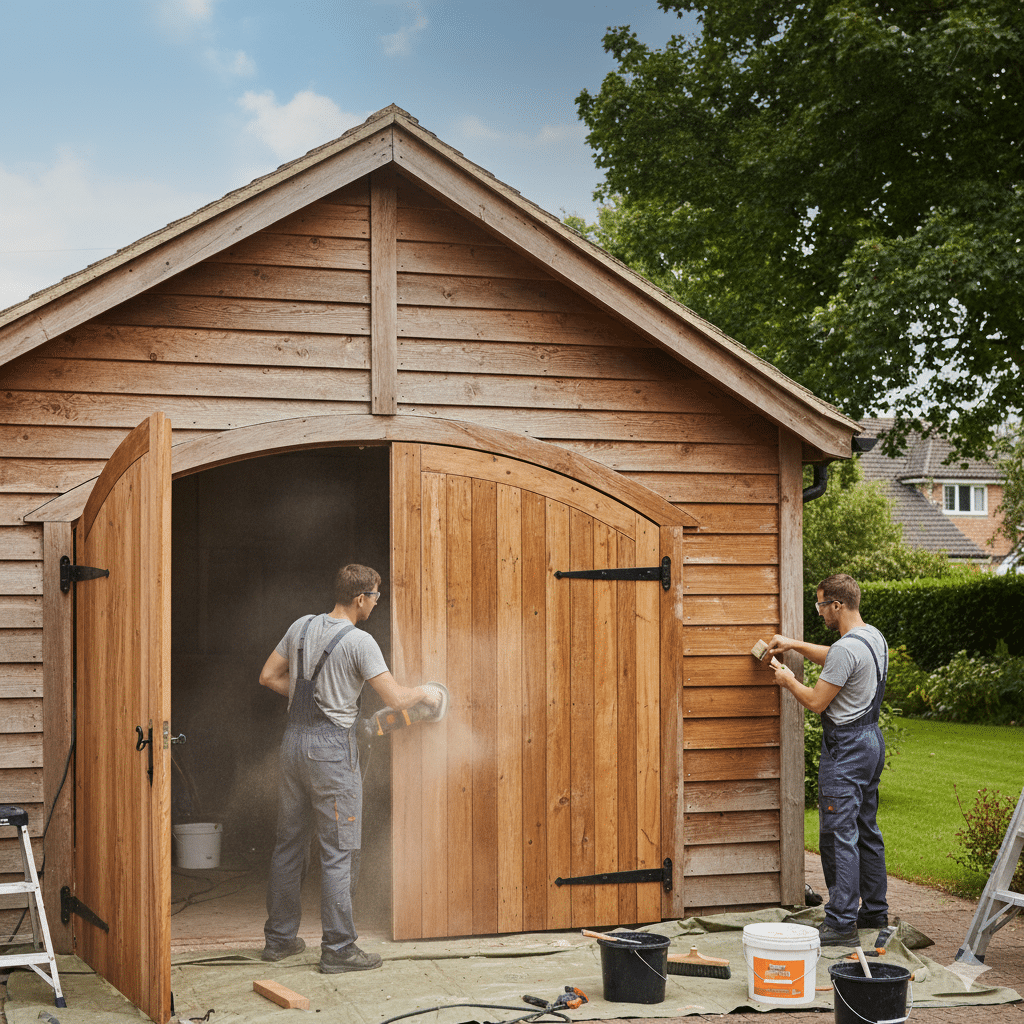
A wooden garage is a significant investment, but New Jersey’s four-season climate presents unique challenges for long-term upkeep. Intense summer humidity, autumn leaf buildup, winter ice, and spring rainfall can cause finishes to fade, moisture to accumulate, and structural joints to weaken. In urban areas like Newark, exposure to pollution and grime accelerates deterioration. This guide outlines proven wooden garage maintenance essentials that will help preserve the appearance and durability of your wooden garage, ensuring it remains both functional and visually appealing for years to come.
How the Local Climate Wears Down Wood
Summer: Heat, Humidity, and UV Rays
Wood expands when the air turns heavy with moisture, creating an open invitation for mold and mildew. Simultaneously, harsh UV rays cause chalk paint to fade, color, and weaken protective stains. As finishes thin out, water finds its way into cracks and crevices, starting the cycle of damage.
Autumn: Falling Debris and Cooling Temperatures
Leaves pile up in gutters and trap moisture against siding, trim, and baseboards. With cooler nights slowing evaporation, this damp blanket creates the perfect breeding ground for rot.
Winter: Snow Load and Freeze-Thaw Stress
Snow and ice add extra weight to rooftops. Ice dams force meltwater beneath shingles, while repeated freeze–thaw cycles widen small gaps, driving water deeper into the wood.
Spring: Heavy Rains and Shifting Ground
Soaked soil and frost heave can shift slabs and footings. Poor drainage leaves water pressing against seams, joints, and fasteners, testing every weak point in the structure.
Your Seasonal Action Plan
Spring: Assess And Clean
- Walk around your property after the thaw; check for soft ground, lifted shingles, and loose fasteners.
- Remove leftover winter debris such as grit, branches, and moss.
- Flush gutters and downspouts; ensure water flows freely and drains away from the foundation.
- Inspect stained surfaces; schedule a re-sealing if the finish looks thin or if water no longer beads.
These wooden garage maintenance tips for seasonal changes matter after a typical New Jersey winter.
Summer: Protect The Shell
- Wash siding gently (low-pressure setting; no blasting).
- Apply a quality water-repellent stain or clear sealant.
- Add vents or keep louvers open to move air and fight humidity.
- Check for ant or carpenter bee activity, especially around eaves.
Plan exterior work during a dry stretch, common late in a New Jersey summer, and perfect for curing finishes in places like Upper Saddle River, NJ.
Autumn: Prep For The Hard Months
- Do one last leaf cleanout; keep gutters and roof valleys open.
- Replace tired weatherstripping on doors and windows.
- Confirm a positive grade so water flows away.
This step pays off around Newark, NJ, where roof runoff and leaf piles can create ice-dam trouble fast.
Winter: Monitor And Respond
- Pull snow from the roof with a rake; keep the head angled to avoid shingle damage.
- Treat ice promptly, heat cables, or use safe de-icing methods around eaves.
- After big nor’easters, do a visual check for sagging lines or popped nails, a smart practice for homeowners in Flemington, NJ.
Proactive Problem-Solving
Catch Early Warning Signs
- Dark, crumbly wood or musty smells point to rot.
- Powdery frass, pinpoint holes, or buzzing at soffits suggest insects.
- Hairline splits, sticky doors, or uneven slabs hint at shifting or moisture changes.
Addressing these quickly is the heart of Wooden Garage Maintenance.
Knowing When To Seek Expert Help
Routine cleaning and sealing are tasks most homeowners can handle with ease. However, major issues like roof leaks, structural shifts, or persistent mold growth require professional wooden garage maintenance services. If your garage needs attention every few months, consider scheduling seasonal maintenance services for wooden garages to keep everything on track and prevent unexpected problems.
Keep Your Investment Working Hard
A steady, seasonal routine is the most reliable way to protect wooden garages from our state’s weather swings. Regular maintenance helps maintain curb appeal, protects the structure, and saves money by addressing small issues before they escalate. It also allows for consideration of upgrading to a new, durable building designed for local conditions. For homeowners in Newark, NJ, and across the state, Sheds for Sale NJ recognizes regional building needs and offers high-quality construction that’s made to last. Contact us today for a consultation on a new, low-maintenance shed or garage built for the New Jersey climate.
FAQs
What’s the best time to stain or paint a wooden garage in New Jersey?
The best timing is late spring to early fall during a dry stretch. Those conditions help exterior stains and paints cure properly and last longer on New Jersey garages outdoors.
How do I prevent ice dams on a wooden garage roof in New Jersey winters?
To prevent ice dams on a wooden garage roof during New Jersey winters, improve attic ventilation, seal air leaks, add insulation, and rake snow to prevent garage roof ice dams. Where needed, install heated de-icing cables along eaves to keep meltwater flowing.
How do humidity and ventilation affect wooden garage maintenance in New Jersey summers?
Summer humidity swells wood and encourages mold; ventilation moves air out. Keep vents clear or add louvers to reduce condensation, protecting wooden garage siding, sheathing, and fasteners from damage.
